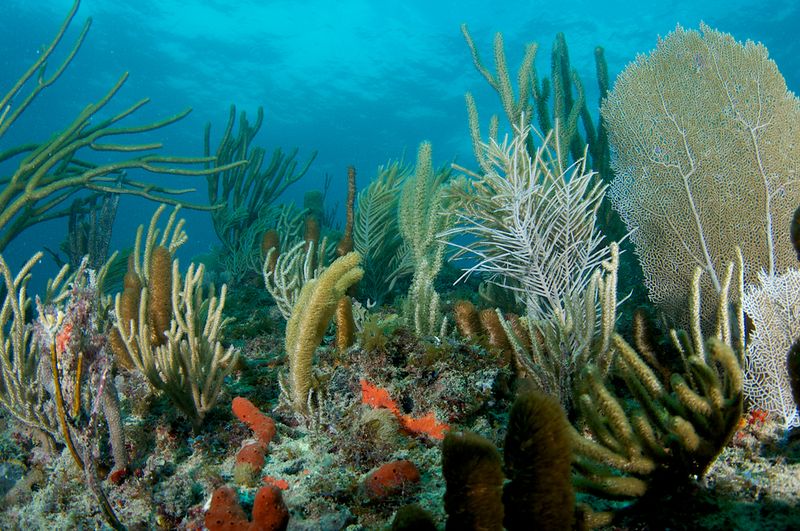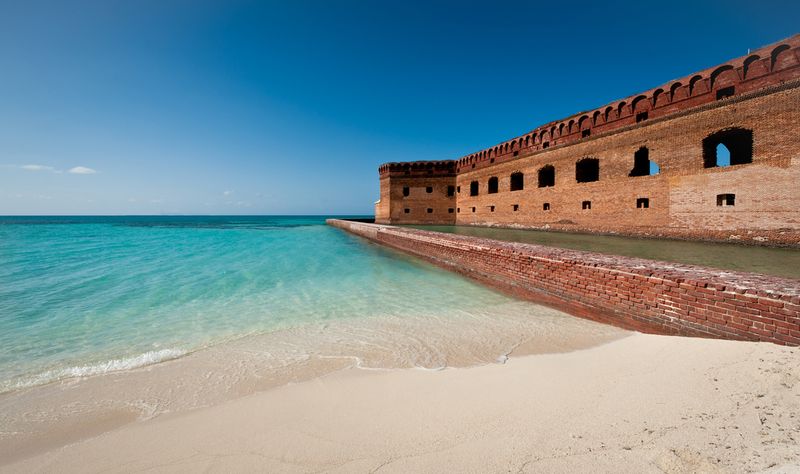
The Sunshine State might be famous for its white sand beaches and tropical blue water, but further north is the place to discover a completely different Florida. After checking out the reefs and sunken shipwrecks of Miami and the Keys, take a break from palm trees and head to the famed cold freshwater springs of North Central Florida, the spot that Jacque Cousteau called “the clearest water in the world.” With so many sunny days year round, Florida is a paradise for underwater exploring.
Advertisement
10. Santa Fe River
Santa Fe River is considered one of the most beautiful and pristine waterways in FL, making it an ideal spot for snorkeling in Florida. You’ll find several launch points in High Springs, a quaint town reminiscent of old Florida with its antique shops, diners, and patio cafes. The 75-mile river is sparsely populated and covered in forests, which provides a habitat for bears, bobcats and the rare Florida Panther. Underwater you’ll find turtles, vegetation, and wading birds as well as small springs and shoals along the way. There are several launch points including US 41/441 Bridge or the US 27 Bridge, which has access to public boat ramps. The water temperature is challenging for some at 72 degrees year round, but with the abundance of sunny, humid days in the Sunshine State, the ice-cold water is the perfect remedy for the oppressive heat.

9. Blue Springs
West of Orange City in Central Florida is a crystalline water oasis in the middle of citrus farms and wild forests. One of the largest springs on St. Johns River is Blue Springs, a favorite spot for manatee sightings. It serves as a crucial winter refuge for the protected West Indian manatee. Mid November to March is manatee season so the park is closed off to water activities, but people flock to the overlooks to see the 100 or so manatees hanging out among the water vegetation. The best time to snorkel is one of the many sunny spring days, that way you’ll beat the summer crowds. With 165 million gallons of fresh water flowing from the spring, the pristine water flows through hardwood, palm forests, and live oak trees along the St. Johns River. Snorkeling is one of the best ways to get an up close look at ancient rocks and marine wildlife.

8. Biscayne National Park
Considered by many to be the true first Florida key is Elliot Key, which contains the beautiful and fragile barrier reef of Bach Shoal. Unless you have your own boat, Biscayne National Park is the easiest way to explore the reefs and hundreds of tropical fish. Just outside of Miami, the park provides a quiet, serene spot tucked away from the crowds and bustling metropolis. Beneath the bright blue water is a wonderland of protected marine wildlife with the Miami Beach skyline in the distance. With 10,000 years of history, including pirates, shipwrecks, and conquistadors, there are many treasures to be found on the shore and underwater. Hunting for lobster is also available at the park with certain restrictions, including the lobster hunting prohibition at the lobster sanctuary at Biscayne Bay-Cord Sound.

7. John Pennekamp Coral Reef State Park
Just an hour outside of Miami is Key Largo, the first key of the iconic Florida Keys and a great spot for a snorkeling day trip. Head south on US 1 and stop off at John Pennekamp Coral Reef State Park, a protected area of ancient mangrove islands, corals, and tropical fish. Camping is available but sometimes it takes up to a year in advance to reserve a spot. Instead, opt for reservations on the park’s pontoon boat that leaves three times a day. A 30-minute boat ride through the mangroves will bring you up close to the delicate coral reef habitat. The tropical waters are warm year round but wet suits are available for rental. Don’t worry if you’re a beginner because the crew is happy to help with equipment. And don’t forget the golden rule of snorkeling the reefs: thou shalt look but not touch.

Advertisement
6. St. Andrews State Park
South Florida might be known for its white sandy beaches and lovely clear blue waters of the Gulf of Mexico, but tucked away just outside Panama City Beach in the Panhandle is a hidden gem for snorkeling and swimming. Surrounded by emerald green waters is the protected area of St. Andrews State Park. The former military reservation features miles of white sand beaches and rock jetties that are amazing spots for exploring hundreds of tropical fish and coral reefs. Feel free to bring your own snorkeling gear or bring a swimsuit and rent a snorkeling set at the concession store. With a variety of marine wildlife and sea plants, prepare to get lost in an underwater utopia. As the staff will most likely remind you, it is important to look but not touch in order to protect the fragile corals from damage and disease.

5. Lauderdale-By-The-Sea
Just outside of the sprawling metropolis of Ft. Lauderdale is Lauderdale-By-The-Sea, a small beach town known as “The Shore Diving Capital of South Florida.” Its claim to South Florida fame is the SS Copenhagen, a designated archaeological underwater preserve called the “Shipwreck Snorkel Trail.” The site can be found from a popular entry point off Datura Street one block south of Commercial Boulevard. While exploring one of the only off shore reefs in Florida, you might get lucky and spot a sea turtle hanging out in the corals among schools of tropical fish. Bring your own gear or rent a snorkel and mask at one of the dive shops nearby. They will also be able to give you current weather conditions and visibility, plus the latest information on the beautiful but struggling coral habitat.

4. Bahia Honda State Park
Situated at Mile Marker 37 near the original Seven Mile Bridge is Bahia Honda State Park and the magnificent Looe Key National Marine Sanctuary where you’ll find prime snorkeling spots. The park is a popular destination for its white sandy beaches and the Elkhorn and Star corals, the main allure of this fragile habitat. The park offers tours to the reef for an hour and a half of underwater exploring. Snorkeling equipment is also available for rental and the boats leave promptly at the dock, so don’t be late. Afterwards, discover an island paradise with emerald waters, ocean breezes, and picture postcard sunsets over the sand dunes. With all that pristine water, it’s the perfect stop to cool off on the way back from Key West or for nature lovers, a full day of water adventures.

3. Ginnie Springs
Just outside of the historic town of High Springs in North Central Florida is Ginnie Springs, a privately owned park that serves as the gateway to some of the most spectacular fresh water springs in the Sunshine State. Make a day out of it and spend a hot afternoon exploring the ice-cold waters of Deer, Twin, and Dogwood Springs, then the larger, more popular Ginnie and Devil Springs along the Santa Fe River. If you still haven’t had your fill of crystal clear, blue water and ancient limestone formations, camping is available right next to the springs or along the river. Imagine watching the setting sun over the Cyprus forest on the river and then waking up with a morning swim in one of the nearby springs, which is some of the purest water in the world. The best time to visit is a weekday when you’ll find the waters undisturbed and only a few campers.

2. Ichetucknee Springs
Ichetucknee Springs is one of the most popular springs in North Central Florida, especially for snorkeling and scuba diving. Situated at the north entrance to Ichetucknee Springs State Park is the springhead, an underwater wonder filled with ancient limestone and bubbling blue waters. Then, after a short hike through a shaded palm and hardwood forest hammock is the Blue Hole, another spring known for its deep blue color and hidden caverns. The best time for snorkeling is on a weekday, preferable in the spring before the summer tubing crowd show up. When the water is its clearest and calmest, you’ll likely see baby turtles, fish, and vegetation, plus the rush of cold 73 degree water on a hot, sunny day. There are also hiking trails, tubing, and canoeing, but snorkeling is one of the best ways to get an up close look at the springs.

Advertisement
1. Dry Tortugas National Park
First discovered by Ponce de Leon in 1513, the legendary explorer named the tiny island Dry Tortugas after the large sea turtle population he found. Later, it was the spot of Fort Jefferson, which still marks the island with its high stoned walls. Situated about 68 miles west of Key West, Dry Tortugas National Park is considered by many to be one of the best places in the Keys for exploring magnificent coral reef habitat. Once you arrive, the park provides all the snorkeling gear, so all you need is a swimsuit for these warm, tropical waters. Keep a lookout for tropical fish and sea turtles hanging out among the corals and the crystal clear blue waters. From the white sandy beaches, the most popular spot to snorkel is about 75 yards from the west edge of the moat. You can either take a ferry or charter boat from Key West to the remote Island or a registered seaplane or even a private boat.

Advertisement